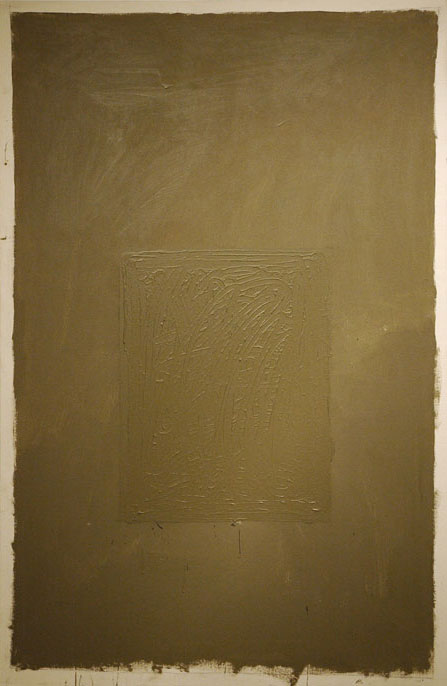
Jonah Koppel Guernsey 2007 synthetic polymer on canvas 61" x 40"

Jonah Koppel East 2007 synthetic polymer on canvas 48" x 32"
These paintings appear as magnificent, breathing monoliths inside the modest white box on Union Avenue. Jonah Koppel's four canvases hang, with their molded, elegant cartouches one alone on each wall of the Klaus von Nichtsagend's exhibition space, and they absolutely will not leave the viewer alone. A look at the description of his working method* is a part of the experience of the art, but the finished work commands respect without any knowledge of Koppel's process.
Caveat: The subtleties of these paintings' textures and color, and the difficulty of recording anything in a mixture of the gallery's natural twilight and electric lighting may have frustrated my attempt to do justice to the subtle tones of these two works.
Disclosure: I am very fond of a crisp Josef Albers silkscreen print (from the "Homage to the Square" series) we've had on our wall for fifteen years; it includes something very similar to these same four tones. I like it even more than that artist's paintings, so I may be predisposed to favor Koppel's chosen colors. But the Albers print has no texture whatsoever, and that is a very different thing.
*
From the press release:
"In my process of abstract painting there are ultimately two approaches that I believe impact my work the most significantly. One is to stretch canvas and begin to paint. The other is to pin the canvas to the wall, paint and then stretch the painting."Using these two approaches, Koppel allows his process to play a prominant role. If the surface is stretched, he determines that the painting will exist only on the front of the canvas, a process that inclines him to end the painting before he reaches the extremities of the canvas. If the painting begins on an unstretched surface it will potentially transform with unpredictable consequences when it is ultimately put on stretchers.
In the center of each painting exists a finger-painted square. This forms the abstracted image element of the otherwise methodologically driven painting. The finger marks represent a gesture that records the physical movement of the artist's finger through wet paint, yet it lacks composition and is inevitably monochromatic. It thus forces the "image" to be discerned only by its surface, which might be understood to be the crux of Koppel's inquiry.
